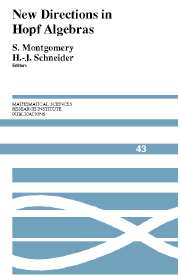Book contents
- Frontmatter
- Contents
- Preface
- Pointed Hopf Algebras
- On the Classification of Finite-Dimensional Triangular Hopf Algebras
- Coideal Subalgebras and Quantum Symmetric Pairs
- Hopf Algebra Extensions and Cohomology
- Finite Quantum Groupoids and Their Applications
- On Quantum Algebras and Coalgebras, Oriented Quantum Algebras and Coalgebras, Invariants of 1-1 Tangles, Knots and Links
- Hopf Algebra Extensions and Monoidal Categories
- A Short Course on Quantum Matrices
- The Brauer Group of a Hopf Algebra
Finite Quantum Groupoids and Their Applications
Published online by Cambridge University Press: 25 June 2025
- Frontmatter
- Contents
- Preface
- Pointed Hopf Algebras
- On the Classification of Finite-Dimensional Triangular Hopf Algebras
- Coideal Subalgebras and Quantum Symmetric Pairs
- Hopf Algebra Extensions and Cohomology
- Finite Quantum Groupoids and Their Applications
- On Quantum Algebras and Coalgebras, Oriented Quantum Algebras and Coalgebras, Invariants of 1-1 Tangles, Knots and Links
- Hopf Algebra Extensions and Monoidal Categories
- A Short Course on Quantum Matrices
- The Brauer Group of a Hopf Algebra
Summary
We give a survey of the theory of finite quantum groupoids (weak Hopf algebras), including foundations of the theory and applications to finite depth subfactors, dynamical deformations of quantum groups, and invariants of knots and 3-manifolds.
1. Introduction
By quantum groupoids we understand weak Hopf algebras introduced in [BNSz], [BSzl], [N]. These objects generalize Hopf algebras (in fact, many Hopf-algebraic concepts can be extended to the quantum groupoid case) and usual finite groupoids (see [NV1] for discussion). Every quantum groupoid has two canonical subalgebras that play the same role as the space of units in a groupoid and projections on these subalgebras generalizing the source and target maps in a groupoid. We use the term “quantum groupoid” instead of “weak Hopf algebra” to stress this similarity that leads to many interesting constructions and examples.
Our initial motivation for studying quantum groupoids in [NV1], [NV2],[N1] was their connection with depth 2 von Neumann subfactors, first mentioned in [02], which was also one of the main topics of [BNSz], [BSzl], [BSz2], [NSzW].
In [NV3] we extended this result to show that quantum groupoids give a description of arbitrary finite index and finite depth Hi subfactors via a Galois correspondence and explained how to express subfactor invariants such as bimodule categories and principal graphs in quantum groupoid terms. Thus, in this respect quantum groupoids play the same role as Ocneanu's paragroups [01], [D].
Information
- Type
- Chapter
- Information
- New Directions in Hopf Algebras , pp. 211 - 262Publisher: Cambridge University PressPrint publication year: 2002
Accessibility standard: Unknown
- 2
- Cited by
